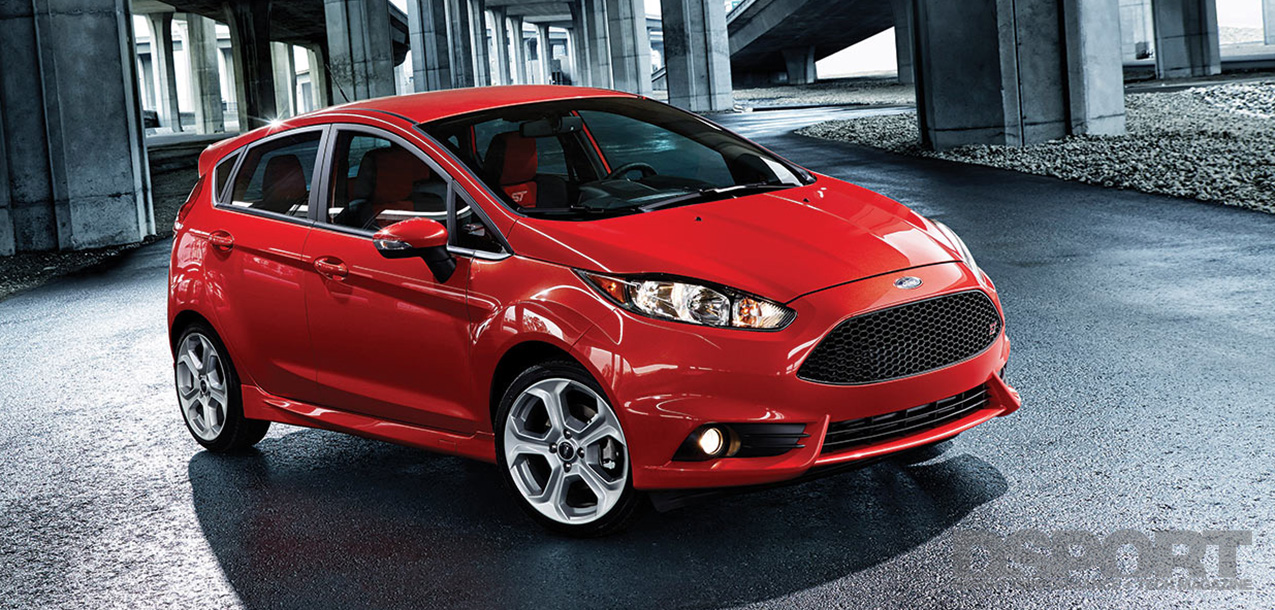The Smaller, The Better?
Don’t go to the grocery store when you’re starving. Why? Because you’ll probably end up with mountains of junk food. Despite most people’s best intentions to diet and eat consciously, obesity now plagues more than one-third of U.S. adults. Unfortunately, the “more is better” motto has also latched onto automakers and their new vehicles.
Text by Jun Chen // Images Courtesy of Ford Motor Company
When it comes to cars, it seems like there’s no reason to hold back. Who doesn’t want more power, more room and an impressive list of standard features? However, in a similar fashion to stuffing your face with chips and candy, there’s a huge downside to the “more to love” motto. That downside, of course, is weight. In the case of Ford’s new Fiesta ST, this hot hatch’s lean waistline and peppy engine help it stand out from the rest.
Lower Standards
 Utilizing a B-segment subcompact platform, the Fiesta ST features a much smaller and lighter chassis than most sporty front-wheel-drive hatchbacks. Weighing just under 2,700 pounds, the Fiesta ST shaves nearly 600 pounds off the curb weight of its bigger brother, the Focus ST. In addition to its low curb weight, the Fiesta ST also benefits from a host of different suspension and steering improvements. Out front, the Fiesta ST implements a set of very trick dynamic, camber-increasing steering knuckles. These knuckles progressively create more camber as the steering wheel turns. Coupled with a quick, electric power-assisted 13.6:1 steering rack, the steering setup made it easy to point the Fiesta in the right direction.
Utilizing a B-segment subcompact platform, the Fiesta ST features a much smaller and lighter chassis than most sporty front-wheel-drive hatchbacks. Weighing just under 2,700 pounds, the Fiesta ST shaves nearly 600 pounds off the curb weight of its bigger brother, the Focus ST. In addition to its low curb weight, the Fiesta ST also benefits from a host of different suspension and steering improvements. Out front, the Fiesta ST implements a set of very trick dynamic, camber-increasing steering knuckles. These knuckles progressively create more camber as the steering wheel turns. Coupled with a quick, electric power-assisted 13.6:1 steering rack, the steering setup made it easy to point the Fiesta in the right direction.
While Ford chose not to include a limited slip differential, they did incorporate a simplified version of the electronic Torque Vectoring Control (eTVC) found on the Focus ST. This system simulates torque vectoring through its ABS system, using the brakes on each wheel to reduce understeer. Combined with the short wheelbase and torquey engine, the Fiesta ST handles unlike any ordinary front-wheel-drive econobox.
Boost Plant
 To power this souped-up Fiesta, Ford dropped in its new 1.6-liter EcoBoost powerplant. Featuring direct injection and a turbocharger, the EcoBoost delivers a stout 180.12 wheel horsepower and 216.76 pound feet of torque on our Dynojet 424xLC2 Linx dynamometer. To increase acceleration, Ford implemented an “overboost†mode, which increases the boost pressure up to 20 psi for up to 20 seconds at wide-open throttle.
To power this souped-up Fiesta, Ford dropped in its new 1.6-liter EcoBoost powerplant. Featuring direct injection and a turbocharger, the EcoBoost delivers a stout 180.12 wheel horsepower and 216.76 pound feet of torque on our Dynojet 424xLC2 Linx dynamometer. To increase acceleration, Ford implemented an “overboost†mode, which increases the boost pressure up to 20 psi for up to 20 seconds at wide-open throttle.
Utilizing a close-ratio, six-speed manual transmission, the Fiesta never feels underpowered on the road. Under 3,000 rpm, the ST feels like any other small compact car. Once the rpms rise and the turbocharger kicks in, the power comes on linearly and keeps rising until you let off and grab the next gear. At highway speeds, a simple downshift will drop you into boost and keep you moving through traffic. The engine delivers power when you need it without it feeling overpowered or uncontrollable. Although the shifter has a bit of a long throw, the smoothness and positive feel of the shifter ranks high compared to other manual gearboxes that we’ve tested.
Rocket Styling
 With increased power and tuned suspension, Ford knew that this hot hatchback needed a matching and sporty guise. On top of the tall wheel arches and short overhangs of the standard Fiesta, the ST model adds a roof-mounted spoiler, painted rear diffuser and revised bumpers. Under the fenders, the ST wears larger 17×7-inch alloy wheels wrapped in 205/40R17 Bridgestone Potenza RE050A summer tires. The ST ditches the base model’s disc/drum setup in favor of four-wheel discs, measuring 10.9-inches in the front and 9.96-inches in the rear. While the brakes don’t feature multiple pistons or drilled/slotted rotors, they stop quickly and deliver confident pedal feel.
With increased power and tuned suspension, Ford knew that this hot hatchback needed a matching and sporty guise. On top of the tall wheel arches and short overhangs of the standard Fiesta, the ST model adds a roof-mounted spoiler, painted rear diffuser and revised bumpers. Under the fenders, the ST wears larger 17×7-inch alloy wheels wrapped in 205/40R17 Bridgestone Potenza RE050A summer tires. The ST ditches the base model’s disc/drum setup in favor of four-wheel discs, measuring 10.9-inches in the front and 9.96-inches in the rear. While the brakes don’t feature multiple pistons or drilled/slotted rotors, they stop quickly and deliver confident pedal feel.



